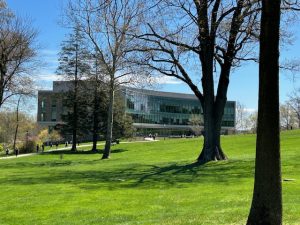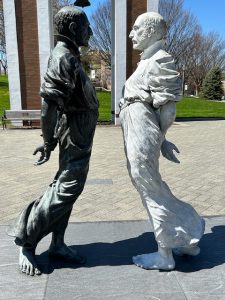Getting To Know: Fairfield University (CT)-Again
In late April I visited two Connecticut schools that are popular with New Jersey’s college-bound students. Fairfield University was the first. My next story will cover Quinnipiac University, a larger school about an hour’s drive from Fairfield. I have added a few photos to my Fairlield University Pinterest page and invite you to read on!
Founded in 1942, Fairfield University is the second-youngest Jesuit university in the United States.
It’s also been a growing school since I last visited seven years ago. Fairfield had just under 4,200 undergrads in 2017. Six years later, it has nearly 5,000. Nearly half are enrolled in the Dolan School of Business. About a third are in the College of Arts and Sciences. The Egan School of Nursing has 15 percent of the undergraduate population. The School of Engineering and Computing is fairly small, with around 300 undergrads. The most popular majors are Finance, Nursing, Marketing, Psychology and Accounting. The university also offers several accelerated programs where students can earn a masters degree in one additional year. These might be a worthwhile option for students who enter with advanced standing in several undergraduate courses. Fairfield also takes career development quite seriously. I have found this to be a strength among the Jesuit schools that I have visited. ,
Fairfield University attracts a very good student.
The university attracts a B+/A- student who is more likely to be Catholic. Eighty percent of the student body comes from four states. New York ranks first followed quite closely by Massachusetts. New Jersey and Connecticut residents round out the quartet. The university has recently expanded its reach into California as well as the Chicago metro area, both places where they have attracted more applicants than in the past.
The average GPA for the Class of 2027 was 3.75. The SAT range for the middle 50 percent of the Class of 2027 for those who submitted scores was between 1250 and 1370. Fairfield has been test optional for more than a decade, with no plans to require testing in the future. There is really no need to submit scores if the undergraduate transcript, outside activities, and the Common App essay is strong. The university does not tie merit award decisions to the scores.
Most recently, less than half of all applicants to the Class of 2027 were accepted.
Nursing is even more selective; the acceptance rate is approximately 25 percent. About a third of all applicants to the business school were admitted. Dolan has had the greatest growth since 2017. Back then there were just under 1,800 undergrads. In 2023 there were more than 2,300.
I recommend a visit before applying.
While there are other Catholic and Jesuit schools in New England and the Mid-Atlantic states, each of their campus communities and locations are unique. Fairfield has a more suburban campus than schools such as Fordham, Holy Cross (MA), Loyola-Maryland, Saint Joseph’s University (PA) and the University of Scranton (PA).
While the campus is only a mile from Metro North trains to New York City, the social life at Fairfield is more likely to be campus based and, in senior year, much happens on Long Island Sound. Fairfield has neither fraternities nor sororities. Nor is it really a “spirit and sports” school like Boston College, Providence, or Villanova. However, I saw quite a few beach party events on YouTube and the women’s basketball team just completed an incredibly successful season. Champions of the Mid Atlantic Athletic Conference (MAAC), they went 28-1 and earned a 12 seed in the NCAA Tournament, falling to 4 seed Indiana..
Fairfield does a very good job at retaining and graduating a class.
Freshmen retention has stayed at 90 percent since the pandemic while 80 percent of a class graduates on time. Unlike larger public colleges and more selective private schools, Fairfield allows students to enter undecided on a major for all programs excluding Nursing. With good advising a student can transfer into business or engineering from the School of Arts & Sciences and still graduate on time.
Fairfield has more liberal arts requirements for business and engineering students than most schools. Being a Jesuit university, Fairfield requires courses in history, religion, and philosophy to graduate. The university makes it quite easy to double, even triple-dip general education requirements to double major or carry multiple minors. Nursing students can actually complete a liberal arts minor, which is less possible at other schools. Students are not likely to see large classes at Fairfield. Even the introductory Biology, Chemistry, Economics and Psychology courses have fewer than 40 students; these are required for several majors.
Merit and need-based scholarships go pretty far down into a freshman class.
Fairfield’s recent Fact Book reported that 96 percent of Fairfield undergrads received merit and or need-based scholarships. The average University Grant for an incoming member of the Class of 2027 was over $28,000 and covered approximately half of tuition and fees. Such an award would have reduced costs to a point where Fairfield became an attractive alternative to non-resident costs at Penn State-University Park, Rutgers-New Brunswick, the University of Connecticut, the University of Delaware, or UMass-Amherst, among others. However, Fairfield is unlikely to undercut Home State U in most states.
Cost-conscious families should be aware that, on average, Fairfield does not cover full need. Fairfield met, on average, 81 percent of need, for freshmen it considered qualified for need-based financial aid during the 2023-24 school year. Sixty percent of the current student body needs to take out loans. So, if a New Jersey family can afford to send a student to Penn State or UConn, among other schools, Fairfield might be no less of a stretch. However, if the budget leans toward a home state school, it is likely that a student would need to borrow beyond the Federal Student Loan program.
The university’s own marketing material states that Fairfield is one of the top five Jesuit colleges for alumni giving.
The university Fact Book stated that 21 percent of Fairfield alumni gave to their alma mater in Fiscal Year 2023. That was up from 14 percent three years before at the height of the COVID 19 pandemic. The average alumni giving rate across all colleges covered by US News last year was eight percent.
Fairfield has nearly 44,000 living undergraduate alumni. Almost a third of undergraduate alumni live in Connecticut. Almost a fifth live in New York. Massachusetts and New Jersey are very well represented, too. Those who come to Fairfield from any of these four states will be able to make good connections for internships and full-time jobs. Not to mention that they are more likely to return to campus, thanks in part to the opening of the Mahoney Arena this past fall. The university and the alumni community raised over $51 million towards construction costs.
The Mahoney Arena (photo up top) is deservedly a signature building on campus.
It helps to keep the community on campus. In prior years Fairfield’s athletic teams played at the Webster Bank (now Total Mortgage) Arena in nearby Bridgeport. Students had to drive to the venue or take buses which impacts attendance and interest. The on-campus arena seats 3,500 for basketball and has premium seating as well. The Mahoney Arena was also host to a campus-wide research symposium on the day that Masha Marcus, a friend and professional colleague, and I visited. I dropped a photo of the symposium below. The arena is also home to the university’s career fairs, important events to have on campus in a venue that appeals to students and recruiters. .
Fairfield has a very well maintained 200-acre hilltop campus with other signature buildings.
The Barone Campus Center as well as the main library are very attractive modern buildings. I dropped photos of the library (left) and the Dolan School of Business building below. I must consider Dolan to be a signature building, given the enrollment in the business school versus the rest of the university.


The Bellarmine Mansion is the signature building where graduation takes place as well as being the offices of the senior administration. The mansion is at the top of a hill where students sled regularly on snowy days. The Eagin Chapel is also an impressive structure. I dropped some photos of the chapel below. Interestingly, for a religiously affiliated school, Fairfield displays little religious symbology outside of the chapel area.



Fairfield University is located in a well-to-do community.
Combining Fairfield and Sacred Heart the community is home to more than 11,000 undergraduates as well as graduate and professional school students. Downtown Fairfield has much of the dining and retail shopping options that students would find in a college town. The university placed their bookstore in the central business district through you will see Fairfield and Scared Heart banners hanging from the street lamps. The university provides shuttle bus service downtown, including the Metro North commuter railroad station with trains to Grand Central Station in New York City. Driving into the city by car is far more difficult because of heavy traffic and continuous road construction on Interstate 95. The Merritt Parkway is another option, but it too can become quite congested.
Fairfield University houses approximately 80 percent of its undergrads on campus.
Fairfield is unique in that incoming students are not allowed to choose their roommate for their first year. The university’s housing office directs the match process. The university also has four first-year living-learning communities, including one for the Honors Program. There is also a three-track residential college program.
The university can house all students who request housing because of the popularity of study abroad programs that take upper-class students away from campus for a semester and also because seniors have the opportunity to live in beachfront homes on Long Island Sound during the shoulder seasons (September/October and April/May) as well as the winter months. Approximately half of the senior class opts to live off campus.
Residence halls and townhomes have plain exteriors though the rooms are fairly spacious. All but one hall has been renovated on the inside, and renovations will be complete for the remaining hall before the Fall 2024 semester. Juniors and seniors have a unique opportunity to “Build a House” where they may organize their own communities around a common theme whether they live in university-owned apartments or townhouses or even off campus.
Conclusions
It’s hard to fault Fairfield. It targets and attracts bright, ambitious students who appear to be reasonably happy with their education, as reflected by the retention and graduation rates as well as the comments from the students that I met. In addition to being in a great location, Fairfield has kept updating its facilities in response to student needs and wants. In addition, Fairfield students can be as intellectually motivated as they want to be. One student who was also an admissions ambassador even presented an analysis of the university’s enrollment management strategy at the research symposium, then walked me thorough it in the admissions office after our tour!

Given that Fairfield grants few doctorates and many master’s degree candidates are employed while pursuing further education, Fairfield undergrads have opportunities to engage in research with faculty, or on their own, that they would not have at larger schools. However, the costs need to work out.
Report Card: Fairfield University
- 4-Year/6-Year Graduation Rates: A/A
- Freshman Retention: A
- Costs: C+
- Curriculum: A
- Community: A
- Comforts: A
- Connections: A (New York City Metro Area)/B (Boston area)/C (elsewhere)
Buy my new book, The Good College!
Listen to my latest interview on ‘Tests and the Rest’ with Amy Seeley and Mike Bergin!
Check out my talk, What Exactly Is a Good College? hosted by test-prep experts Amy Seeley and Mike Bergin on Tests And The Rest!
Listen to my talk, College Is A Learning AND Living Community hosted by Dr. Cynthia Colon from Destination YOUniversity on Voice of America Radio!
Sharing is caring!


